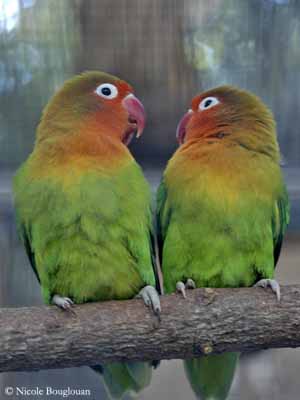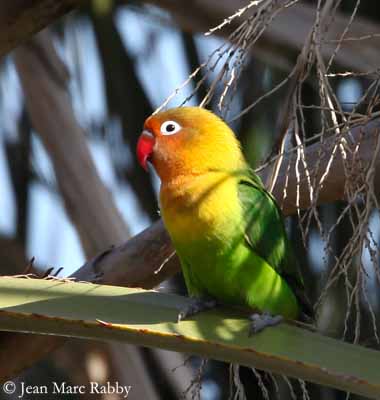
Fischer’s Lovebird
Agapornis fischeri
Psittaciforme Order – Psittaculidae Family
BIOMETRICS:
Length: 15 cm
Weight: 42-58 g
DESCRIPTION:
This small parrot is named after German explorer Gustav Fischer.
The Fischer’s Lovebird has been discovered in the late 1800s. It is a common cagebird.
Fr: Inséparable de Fischer
All : Pfirsichköpfchen
Esp : Inseparable de Fischer
Ital : Inseparabile di Fischer
Nd : Fischer-agapornis
Sd: Rödhuvad dvärgpapegoja
Photographs of the wild birds by Jean Marc Rabby
Des Ailes et des Plumes
Photographs of captive birds and text by Nicole Bouglouan
Sources :
HANDBOOK OF THE BIRDS OF THE WORLD vol 4 by Josep del Hoyo-Andrew Elliott-Jordi Sargatal - Lynx Edicions - ISBN: 8487334229
PARROTS OF THE WORLD – An Identification Guide – by Joseph M. Forshaw – Princeton University Press – ISBN 0691092516
BirdLife International (BirdLife International)
Wikipedia (Wikipedia, The Free Encyclopedia)

Both adults are similar. They have dark green back, wings and tail. Rump and uppertail coverts are dark blue. Tail is green with orange edges on external rectrices and black subterminal band on the same feathers. Terminal band is blue-green.
On the underparts, lower breast and belly are green, paler than above. Underwing shows blackish flight feathers and green wing coverts.
On the head, forehead is red. Face is orange-red. Rest of head is dull olive-green tinged rufous shading on the nape. Neck sides and throat are pinkish-orange to yellowish-pink on the breast.
The hooked bill is red with white base on upper mandible. Eyes are dark brown, surrounded by conspicuous white eye-ring of bare skin. Legs and feet are pale grey.
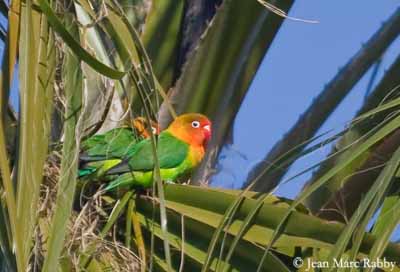
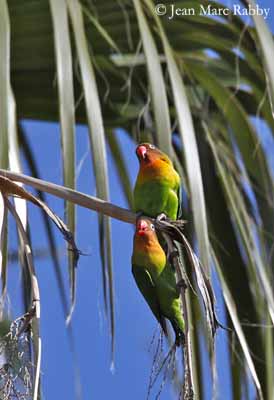
Juvenile is duller than adults, with black base on upper mandible.
Immature has duller head.
Among the birds of feral populations, there are several hybrids A. fischeri x A. personatus (Yellow-collared Lovebird).
Hybrid has dark brown head, as a hood. Upper breast is orange and lower breast is yellow. Nape and upper back are blackish-yellow.
VOICE: SOUNDS BY XENO-CANTO
The Fischer’s Lovebird gives high-pitched twittering and whistling with sharp “chirrik…chirrik…” and more melodious notes “chirreek”.
It also utters shrill “tingk…tingk”, and several harsh notes.
HABITAT:
The Fischer’s Lovebird frequents wooded grasslands with scattered trees (Acacias and other plant species), at 1100-2200 metres of elevation. In the western parts of the range, it is found in cultivated areas.
This species is common in reserves, but the heavy trapping for cagebird trade makes it locally scarce, with important decline since 1970s.
It avoids miombo woodlands (miombo is the Swahili word for Brachystegia, a genus of tree native to tropical Africa).
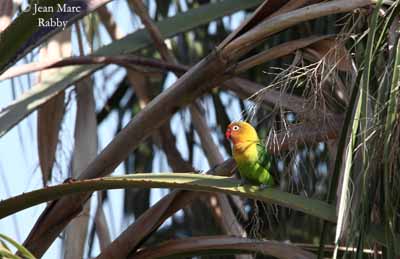
RANGE:
The Fischer’s Lovebird is found in North and Centre Tanzania. Several cities have their feral population.
In driest conditions, populations may move west into Rwanda and Burundi for moister weather conditions.
A small feral population occurs in SE France, in Saint Jean Cap Ferrat. But there are probably other groups in other towns and cities.
BEHAVIOUR:
The Fischer’s Lovebird is primarily granivorous, feeding on seeds from grass and weeds. It also takes seeds from acacias, directly from the tree or on the ground.
It also feeds on fruits from several trees and plant species.
This parrot needs to drink every day and moves for that during the driest period.
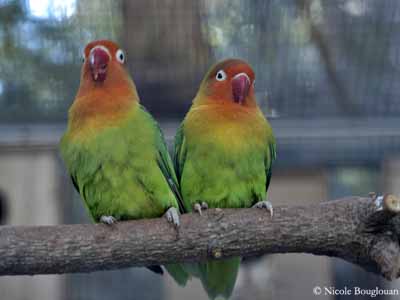
The Fischer’s Lovebird is resident within its range, but the birds perform local movements for water.
They are gregarious and noisy as most of Psittacidae. They usually live in groups of up to 20 birds, but the crops attract larger flocks.
They form mixed flocks with Yellow-collared Lovebird and hybrids in feral populations.
During daytime, the Fischer’s Lovebird has varied activities. Usually, they feed in the early morning. During the hottest hours of midday, they rest and perform social activities such as mutual preening and allofeeding. In the late afternoon, they feed again and visit the water holes to drink, and probably to bathe.
Just before sunset, they return to the roost-site in noisy flocks.
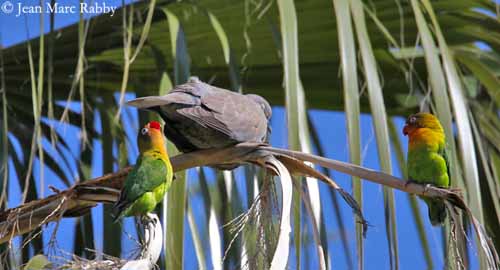
FLIGHT:
The Fischer’s Lovebird has fast and straight flight, with buzzing sounds produced by the rapid wing beats.
REPRODUCTION:
Breeding season occurs from January to April and from June to July.
The nest of the Fischer’s Lovebird is a hole in dead tree, or in dead branch of living tree, often an abandoned woodpecker nest, and also in natural cracks in branches. Some nests are built at frond bases of palms and there are probably others in cliffs.
The nest is usually between 2 and 15 metres above the ground.
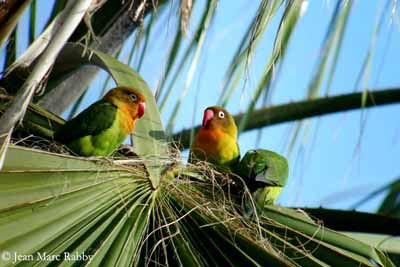
In captivity, female lays 3-8 white eggs. Incubation lasts about 23 days by female. The nesting period lasts 38-42 days before the chicks fledge.
DIET:
The Fischer’s Lovebird feeds mainly on seeds, but it also takes fruits.
It feeds on seeds of grass Penisetum mezianum, of weed Achyranthes asper, and also takes Acacia seeds from the tree or on the ground.
Fruits include Rhus villosa, Commiphora and Ficus capensis.
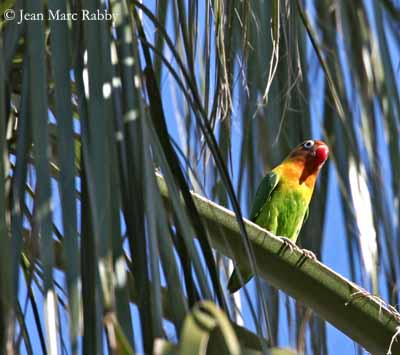
PROTECTION / THREATS / STATUS:
The Fischer’s Lovebird is classified as Near Threatened.
As numerous Psittaciformes, they were heavily trapped for cagebird trade, and declines regularly occurred in the restricted range.
In the years 1982-1990, about 56 000 birds were exported per year.
Today, trapping has been stopped, but populations remain under protection and survey.
